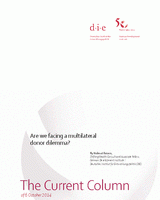Are we facing a multilateral donor dilemma?
Reisen, HelmutThe Current Column (2014)
Bonn: German Development Institute / Deutsches Institut für Entwicklungspolitik (DIE) (The Current Column of 6 October 2014)
Bonn, Berlin, 6 October 2014. Following a decade and a half of convergence and poverty reduction in developing and emerging economies, proclamations abound that ‘We Can End Poverty’. The end of poverty has been given a precise meaning: in 2030, no more than three percent of the world's population should have to survive on a daily income of USD 1.25 or less. At the same time, it is forecast that fewer countries will be eligible to receive grants or soft loans from the World Bank’s International Development Association (IDA) and other multilateral finance institutions. Countries usually lose their IDA eligibility as soon as their annual per-capita income exceeds USD 1,195, when they graduate to middle-income status. Will the end of poverty result in a donor dilemma?
It is often claimed that middle-income countries have barely any need for development aid, while nations still classified as low-income countries are usually so fragile and ungovernable that they cannot absorb aid efficiently. Does this mean that it is time for multilateral finance institutions to close their concessional windows? The debate is particularly focused on IDA, the world’s largest multilateral provider of grants and soft loans.
The German Federal Ministry for Economic Cooperation and Development (BMZ) has just released a study on that debate, entitled ’The Future of Multilateral Concessional Finance’. The study uses IMF projections for quantifying graduation and poverty scenarios for the coming decade. It claims that previous scenarios have been too optimistic by making linear out-of-sample forecasts based on the last decade. Such scenarios are unrealistic, as the growth achieved by developing and emerging countries over the last decade has been attributable in large part to China’s unsustainable growth rates and to very expansive monetary policy of industrialised nations.
The basic scenario forecasts that some 26 countries (down from 39 at present) will still have IDA eligibility in 2025, with over half a billion people still living in extreme poverty (the current figure exceeds one billion). Half of these individuals will live in the Democratic Republic of Congo, India and Nigeria, the latter two nations likely losing IDA eligibility. Consequently, the donor community is faced with the question of whether it wishes to bypass most of the world's poor in its aid allocation because they do not live in low-income countries (any longer).
The recent growth performance of many middle-income countries suggests that higher domestic resource mobilisation may replace foreign aid to solve their own distribution and poverty problems. However, the BMZ study presents calculations that caution against over-optimism in this regard. In order to solve their poverty gap, most countries would need prohibitively high marginal tax rates and a level of fiscal federalism that would be difficult to achieve politically.
In our age of Anthropocene, natural disasters are becoming more frequent and intense, threatening to undermine efforts to combat extreme poverty. If climate change is to be taken into account when allocating grants and soft loans, new allocation criteria are needed, with less emphasis on policy performance and more on vulnerability. The great uncertainty surrounding future trends in global poverty calls for a gradual, cautious and risk-based approach to the institutional reform of development banks. The options are as follows:
Revise the IDA-eligibility criteria: The current GDP per capita threshold of USD 1,195 for IDA eligibility could be revised to prevent the majority of the world's poorest people from losing out on the benefits of multilateral aid.
- Smooth the transition periods: The BMZ study refers to a previous threshold for IDA eligibility (approx. USD 2,000), which could define a transition from the current IDA threshold for per-capita annual income (USD 1,195). The transition would still include soft loans, but would be more closely conditioned on countries' own distribution policies and the ‘greening’ of funded projects.
- Strengthen sub-sovereign allocation: To take account of rural-urban poverty duality present in many large countries and of higher disaster risk in certain provinces, multilateral aid could be increasingly provided to sub-sovereign entities and non-governmental organisations.
- Open concessional windows for global public goods: The cost of climate change and the existence of geographically concentrated hotspots of extreme poverty and vulnerability to natural disaster make it advisable for multilateral development banks to use their finance to tackle both poverty and climate change simultaneously.
The division of labour among the IFIs needs to be reorganised to reduce overlap in their increasingly African borrower portfolio. Greater subsidiarity and regional differentiation are called for in light of the expected rise of heterogeneity in economic growth and poverty hotspots. Vulnerability indicators will have to take precedence over performance in the allocation of concessionary finance going forward.
Helmut Reisen, ShiftingWealth Consult and Associate Fellow, German Development Institute / Deutsches Institut für Entwicklungspolitik (DIE)
